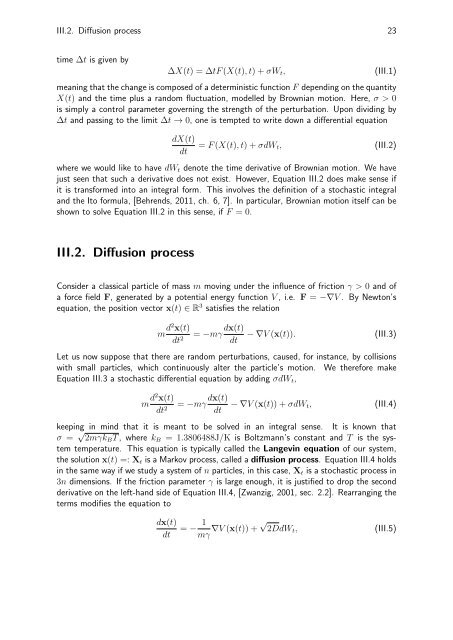Variational Principles in Conformation Dynamics - FU Berlin, FB MI
Variational Principles in Conformation Dynamics - FU Berlin, FB MI
Variational Principles in Conformation Dynamics - FU Berlin, FB MI
- No tags were found...
Create successful ePaper yourself
Turn your PDF publications into a flip-book with our unique Google optimized e-Paper software.
III.2. Diffusion process 23time ∆t is given by∆X(t) =∆tF (X(t),t)+σW t ,(III.1)mean<strong>in</strong>g that the change is composed of a determ<strong>in</strong>istic function F depend<strong>in</strong>g on the quantityX(t) and the time plus a random fluctuation, modelled by Brownian motion. Here, σ>0is simply a control parameter govern<strong>in</strong>g the strength of the perturbation. Upon divid<strong>in</strong>g by∆t and pass<strong>in</strong>g to the limit ∆t → 0, oneistemptedtowritedownadifferentialequationdX(t)dt= F (X(t),t)+σdW t , (III.2)where we would like to have dW t denote the time derivative of Brownian motion. We havejust seen that such a derivative does not exist. However, Equation III.2 does make sense ifit is transformed <strong>in</strong>to an <strong>in</strong>tegral form. This <strong>in</strong>volves the def<strong>in</strong>ition of a stochastic <strong>in</strong>tegraland the Ito formula, [Behrends, 2011, ch.6,7].Inparticular,Brownianmotionitselfcanbeshown to solve Equation III.2 <strong>in</strong> this sense, if F =0.III.2. Diffusion processConsider a classical particle of mass m mov<strong>in</strong>g under the <strong>in</strong>fluence of friction γ>0 and ofaforcefieldF, generatedbyapotentialenergyfunctionV ,i.e. F = −∇V . By Newton’sequation, the position vector x(t) ∈ R 3 satisfies the relationm d2 x(t)dt 2= −mγ dx(t)dt−∇V (x(t)).(III.3)Let us now suppose that there are random perturbations, caused, for <strong>in</strong>stance, by collisionswith small particles, which cont<strong>in</strong>uously alter the particle’s motion. We therefore makeEquation III.3 astochasticdifferentialequationbyadd<strong>in</strong>gσdW t ,m d2 x(t)dt 2= −mγ dx(t)dt−∇V (x(t)) + σdW t ,(III.4)keep<strong>in</strong>g <strong>in</strong> m<strong>in</strong>d that it is meant to be solved <strong>in</strong> an <strong>in</strong>tegral sense. It is known thatσ = √ 2mγk B T ,wherek B =1.3806488J/K is Boltzmann’s constant and T is the systemtemperature. This equation is typically called the Langev<strong>in</strong> equation of our system,the solution x(t) =:X t is a Markov process, called a diffusion process. Equation III.4 holds<strong>in</strong> the same way if we study a system of n particles, <strong>in</strong> this case, X t is a stochastic process <strong>in</strong>3n dimensions. If the friction parameter γ is large enough, it is justified to drop the secondderivative on the left-hand side of Equation III.4, [Zwanzig, 2001, sec. 2.2].Rearrang<strong>in</strong>gtheterms modifies the equation todx(t)dt= − 1mγ ∇V (x(t)) + √ 2DdW t ,(III.5)









